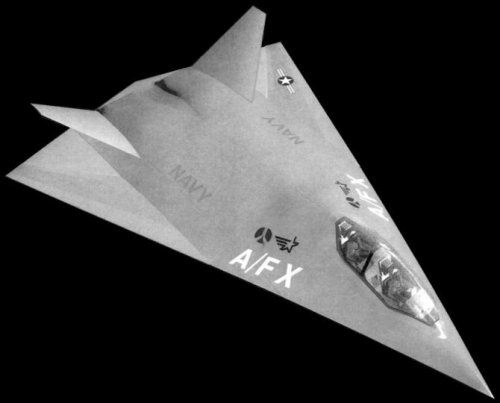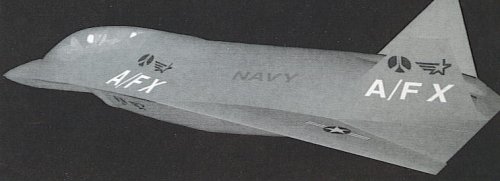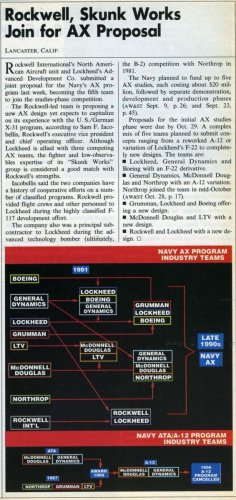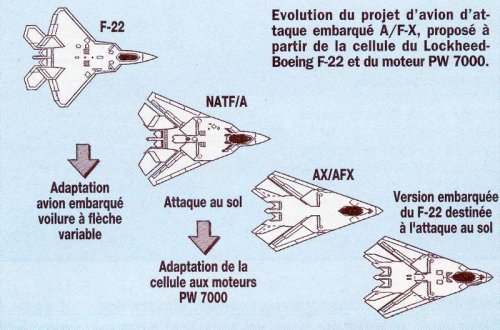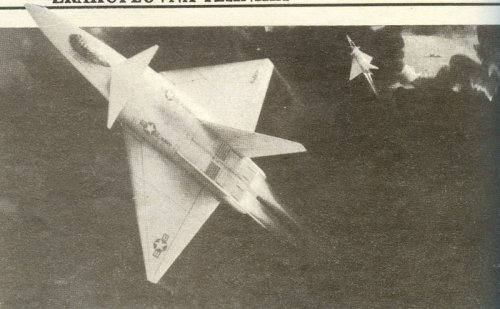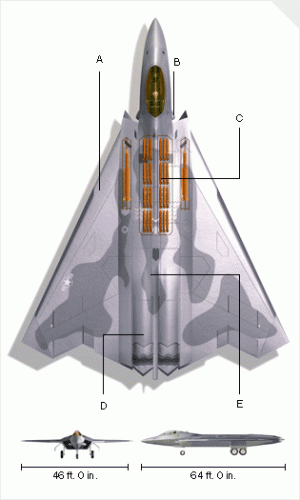You are using an out of date browser. It may not display this or other websites correctly.
You should upgrade or use an alternative browser.
You should upgrade or use an alternative browser.
Navy AX and A/F-X projects
- Thread starter Rafael
- Start date
Kim Margosein
ACCESS: Confidential
- Joined
- 9 February 2007
- Messages
- 101
- Reaction score
- 13
Just a guess- a Rockwell/Lockheed A-12 competitor?
Kim M
Kim M
- Joined
- 1 April 2006
- Messages
- 11,363
- Reaction score
- 10,147
Obviously, this is Advanced/Fighter-Attack (A/F-X) competition entry, what, in fact, onboard markings say. http://www.globalsecurity.org/military/systems/aircraft/a-x.htm Wery sceptic about the fact that any additional pics were released so far.
All images published has one source - brilliant Stevenson's The $5 Billion Misunderstanding: The Collapse of the Navy’s A-12 Stealth Bomber Program published by the Naval Institute Press in the Fall of 2001. (www.a-12.com)
All images published has one source - brilliant Stevenson's The $5 Billion Misunderstanding: The Collapse of the Navy’s A-12 Stealth Bomber Program published by the Naval Institute Press in the Fall of 2001. (www.a-12.com)
Attachments
Thorvic said:That look VG BTW ?
G
Now that you mention it.... and the side view is a little more revealing.
It has some resemblance to the NATF model, or am I seeing things?
Would be fine to have an underside look
Rafa
- Joined
- 17 October 2006
- Messages
- 2,393
- Reaction score
- 1,195
It's also in Jay Miller's Skunk Works book - and it is a Rockwell/Lockheed study. (The two companies did talk to each other - they had considered getting together for ATB.) Lockheed had at least two designs in A/F-X in the 1992-94 timeframe, the other being a distant cousin of the F-22 with GD and Boeing. (It was a swing wing with origins in NATF.)
The whole picture at the time was very confused, with AX - essentially a watered-down A-12 - being followed very quickly by A/F-X, which was intended to replace the F-14 and the A-6. What made it confused was that everyone had multiple offerings - some based on their old alignments, like Macs and GD, and some being new. Where it would have fitted in the USAF inventory I can't imagine, since the F-15E was new and the F-111 was already on its way out of the door. It did not matter since the entire project was whacked in 1993, although Lockheed continued to brief it into early 1994.
The whole picture at the time was very confused, with AX - essentially a watered-down A-12 - being followed very quickly by A/F-X, which was intended to replace the F-14 and the A-6. What made it confused was that everyone had multiple offerings - some based on their old alignments, like Macs and GD, and some being new. Where it would have fitted in the USAF inventory I can't imagine, since the F-15E was new and the F-111 was already on its way out of the door. It did not matter since the entire project was whacked in 1993, although Lockheed continued to brief it into early 1994.
Matej
Multiuniversal creator
Funny that the first picture is the one, that I retouched a bit to better show the details as VG wing or the cockpit  I also think, that this design can be a explanation of the AX-17 rumour. It has a lot of commonalities.
I also think, that this design can be a explanation of the AX-17 rumour. It has a lot of commonalities.
Sentinel Chicken
American 71 Heavy, contact departure 126.47
I searched the forums for more on this and other than a thread discussing the Tomcat 21/Tomcat II here (http://www.secretprojects.co.uk/forum/index.php/topic,589.0.html), I've not found much as of yet. What I have read so far is that the A/FX program was short lived being set up following the cancellation of the A-12 Avenger II. The Navy had the A-X program for an A-6 replacement as well as the NATF for a navalized version of the ATF and the USAF was looking for an F-111 replacement. So as I understand it, those three programs became the A/FX in 1991 but would be cancelled in 1993, eventually morphing into the JSF via the JAST program.
A 1994 issue of Flight International had a provisional 3 view drawing of what looked like a YF-22-based two seater with swing-wings. My understanding is that design was a Lockheed/Boeing design designated AFX-653. However I had read somewhere else that provisional drawing wasn't the Lockheed/Boeing design.
Whose design is it and what, if any, other competitor designs were submitted for A/FX?
A 1994 issue of Flight International had a provisional 3 view drawing of what looked like a YF-22-based two seater with swing-wings. My understanding is that design was a Lockheed/Boeing design designated AFX-653. However I had read somewhere else that provisional drawing wasn't the Lockheed/Boeing design.
Whose design is it and what, if any, other competitor designs were submitted for A/FX?
There was an A-12 derived design with cranked outer wing panels.
I got this info from the Invisible Defenders website, which unfortunately appears to be defunct. Aside from the AFX-653 concept and the A-12 derivative, I don't have much info on A-X and A/F-X proposals.
I got this info from the Invisible Defenders website, which unfortunately appears to be defunct. Aside from the AFX-653 concept and the A-12 derivative, I don't have much info on A-X and A/F-X proposals.
Last edited by a moderator:
Matej
Multiuniversal creator
All concepts that I collected are here: http://www.hitechweb.genezis.eu/stealth4.htm
- Joined
- 17 October 2006
- Messages
- 2,393
- Reaction score
- 1,195
It's possible that they came out of Lockheed briefings at Asian Aerospace in 1994, given by a chap named Burbage who was never heard of again. Maybe that version was filed with Interavia and published with changed captions in Air & Cosmos, but that's just a rumor.
Maki
Anytime Baby!!!
- Joined
- 2 September 2007
- Messages
- 22
- Reaction score
- 11
Found this picture in one of my old magazines. It says that it's a early concept for the A/X program for the navy. Doesn't say whose concept it is,but since it reminds me of Lockheed's early sketches for the ATF program I presume that it was one of their bids.
Attachments
- Joined
- 17 October 2006
- Messages
- 2,393
- Reaction score
- 1,195
It's a PR image... doubtless vetted to make sure it did not look like anything real.
Maki
Anytime Baby!!!
- Joined
- 2 September 2007
- Messages
- 22
- Reaction score
- 11
So the magazine was wrong,it actually wasn't a AX proposal but PR artwork from the NATF  . Sorry about that. I honestly thought it was a genuine AX proposal.And all this time I was wondering why a single-seat delta-canard configuration was chosen for a carrier based strike fighter when it is well known that the navy prefers two-seat and a wing configuration better optimized for carrier landings.
. Sorry about that. I honestly thought it was a genuine AX proposal.And all this time I was wondering why a single-seat delta-canard configuration was chosen for a carrier based strike fighter when it is well known that the navy prefers two-seat and a wing configuration better optimized for carrier landings.
- Joined
- 17 October 2006
- Messages
- 2,393
- Reaction score
- 1,195
Maki,
I'm not sure why the Navy hates canards. They can certainly work fine for carrier landings because they can be set up for low approach speeds (Rafale) with moderate angle of attack. And canards can be stealthy too (X-36). Northrop Grumman proposed a species of canard, the hammerhead LEX, for JSF, before teaming with Macs and losing.
I'm not sure why the Navy hates canards. They can certainly work fine for carrier landings because they can be set up for low approach speeds (Rafale) with moderate angle of attack. And canards can be stealthy too (X-36). Northrop Grumman proposed a species of canard, the hammerhead LEX, for JSF, before teaming with Macs and losing.
Maki
Anytime Baby!!!
- Joined
- 2 September 2007
- Messages
- 22
- Reaction score
- 11
Of course delta-canards can land on carriers,that is not an issue,but since the A/F-X is a bigger and heavier bird then the Rafale,to operate at slow speeds would probably require more enlarged control surfaces (larger canards) which could complicate things. I have read that in the beginning of the JSF competition Lockheed started out with a delta-canard design but abandoned it for a number of reasons,among which was the Navy's requirement for controllability at slow speeds during carrier landings. They started enlarging the canards to try to meet the requirements but noticed that their size was starting to grow to big and that it degraded other elements of their design. Instead of pursuing this route Lockheed chose to switch to a conventional tailplane design,which would eliminate a great technical risk and speed up development.
So I guess that is the reason the Navy isn't fond of delta-canards,v-tails or any other unconventional solution. They don't like great risks,especially after the A-12 fiasco. Perhaps that's why some of the A/F-X proposals have variable geometry wings. But then you have to wonder what are the RCS numbers for swing wing designs,so they present a risk of their own.
So I guess that is the reason the Navy isn't fond of delta-canards,v-tails or any other unconventional solution. They don't like great risks,especially after the A-12 fiasco. Perhaps that's why some of the A/F-X proposals have variable geometry wings. But then you have to wonder what are the RCS numbers for swing wing designs,so they present a risk of their own.
LowObservable said:Maki,
I'm not sure why the Navy hates canards. They can certainly work fine for carrier landings because they can be set up for low approach speeds (Rafale) with moderate angle of attack. And canards can be stealthy too (X-36). Northrop Grumman proposed a species of canard, the hammerhead LEX, for JSF, before teaming with Macs and losing.
If I understand the speculation on the Naval F-23 correctly, Northrop proposed a canard on their navalized F-23. The wing would be moved aft, and the ruddervators would be replaced with canted vertical stabilizers.
- Joined
- 3 January 2006
- Messages
- 1,222
- Reaction score
- 932
LowObservable said:Maki,
I'm not sure why the Navy hates canards. They can certainly work fine for carrier landings because they can be set up for low approach speeds (Rafale) with moderate angle of attack. And canards can be stealthy too (X-36). Northrop Grumman proposed a species of canard, the hammerhead LEX, for JSF, before teaming with Macs and losing.
Correct me if I'm wrong, but didn't Lockheed droped canards from its ASTOVL/JAST/JSF proposals when it was determined that to maintain effectiveness as a control surface, a "stealthy canard" would have been prohibitively large and heavy?
I won't deny that the Rafale M has a lower approach speed and more moderate angle of attack than the first generation Hornet, allowing for a far less robust landing gear - although there seems to be no great advantage in terms of overall structural weight. However, a usefully lower approach speed was accomplished with the second generation Super Hornet by the simple expendient of increasing wing area.
- Joined
- 2 August 2006
- Messages
- 3,253
- Reaction score
- 1,520
Actually, you're incorrect regarding "risk aversion." The reason the JSF went from a canard to a tailed aircraft is the same reason the ATF prototypes didn't have canards; Canards have a more limited AOA capability when compared to a standard tailed aircraft. Especially in the naval environment where they have the bring back weight requirement coupled with the WOD requirement. The simple fact is the tailed aircraft was the better solution to this problem than the canard configuration was and was also the reason the X-32 gained a horizontal tail. I seriously doubt the Rafale comes anywhere near meeting the U.S. navy's requirements in this regard.
It wasn't about risk, it was about what was the best design to meet the requirements, pure and simple. The mission drives the design, not the other way around.
It wasn't about risk, it was about what was the best design to meet the requirements, pure and simple. The mission drives the design, not the other way around.
- Joined
- 3 January 2006
- Messages
- 1,222
- Reaction score
- 932
Here is the definitive Flight International article on the A/F-X:
http://www.flightglobal.com/PDFArchive/View/1994/1994 - 0212.html
http://www.flightglobal.com/PDFArchive/View/1994/1994 - 0213.html
http://www.flightglobal.com/PDFArchive/View/1994/1994 - 0212.html
http://www.flightglobal.com/PDFArchive/View/1994/1994 - 0213.html
Attachments
Last edited by a moderator:
- Joined
- 27 December 2005
- Messages
- 17,706
- Reaction score
- 26,136
Nice find Jay. Interesting description of earlier iteration of the design.
- Joined
- 17 October 2006
- Messages
- 2,393
- Reaction score
- 1,195
Very interesting, particularly the comments on F-22 LO (primarily air to air) versus the early A/F-X (not the one in the pix, but the pure wedge with folding tails). We're seeing the same argument emerge today, with people once again saying that it's only a tailless, all-wing shape that will give you all-aspect, wideband LO.
That Burbage fella always seemed a promising chap. Wonder whatever happened to him?
That Burbage fella always seemed a promising chap. Wonder whatever happened to him?
- Joined
- 1 April 2006
- Messages
- 11,363
- Reaction score
- 10,147
LowObservable said:That Burbage fella always seemed a promising chap. Wonder whatever happened to him?
LO, are you kidding as always?)))
Tom Burbage (LM Aero Executive Vice President and General Manager for JSF)
- Joined
- 17 October 2006
- Messages
- 2,393
- Reaction score
- 1,195
Oh.
HIM.
Now I remember. ;D
HIM.
Now I remember. ;D
Maki
Anytime Baby!!!
- Joined
- 2 September 2007
- Messages
- 22
- Reaction score
- 11
Does anybody know anything more about the nozzle that was used by Lockheed's A/F-X in the wedge shaped configuration ? In the article that was posted by TinWing, the author said that initially the thrust vectoring nozzles were used for pitch,roll and yaw. Later this was deleted when they switched to the notched configuration of the aircraft, and the nozzles were used only for pitch and roll. What interests me is how did they make a low IR/radar stealthy nozzle that works in yaw and pitch. Somehow i doubt they used paddles like on the X-31 or a nozzle like on the F-15 ACTIVE.
- Joined
- 17 October 2006
- Messages
- 2,393
- Reaction score
- 1,195
Similar threads
-
-
-
-
-
Tube-launched Air to air Missiles
- Started by Rafael
- Replies: 19

